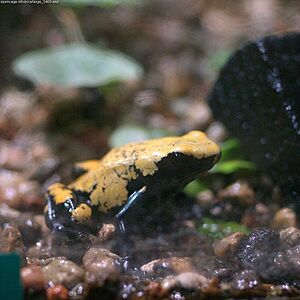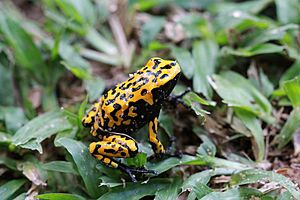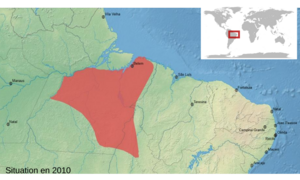Splashback poison frog facts for kids
Quick facts for kids Splashback poison frog |
|
|---|---|
 |
|
 |
|
| Yellow-backed variant (above, captive) and yellow-and-black netted variant (below, from Cristalino State Park) | |
| Conservation status | |
| Scientific classification | |
 |
|
| Distribution of the splash-backed poison frog | |
| Synonyms | |
|
Dendrobates galactonotus Steindachner, 1864 |
The splash-backed poison frog (Adelphobates galactonotus) is a fascinating type of poison dart frog. These colorful frogs are found only in the warm, wet rainforests of the southern Amazon Basin in Brazil. They are known for their bright colors and unique patterns.
Contents
About the Splash-backed Poison Frog
Splash-backed poison frogs are small but mighty. They are a type of amphibian, meaning they can live both on land and in water. These frogs are famous for their vibrant skin colors. Their skin can be yellow, orange, red, or even light blue.
Where Do They Live?
These frogs live only in one specific area. This is called being endemic. Their home is the tropical lowland forests of the southern Amazon. This means they need a warm, moist environment to survive. They thrive in places with lots of trees and plants.
What Do They Look Like?
Splash-backed poison frogs are quite small. They can grow up to about 4.2 centimeters (1.7 inches) long. This is about the length of your thumb! Their colors are incredibly varied.
- Some frogs have a black body with a bright yellow, orange, or red back.
- Others might have whitish-mint or light blue on their upper parts.
- You can also find them with spotted or mottled patterns.
- Some are almost entirely whitish, called "moonshine" by frog enthusiasts.
- There's even a special type from Cristalino State Park with a yellow and black net-like pattern.
Scientists once thought these different color types might be separate species. But genetic tests showed they are all the same frog! Their colors don't follow clear geographic lines. This means different colors can live in the same area.
Life Cycle and Reproduction
The splash-backed poison frog has an interesting way of raising its young. The female frog lays her eggs on the ground. These eggs are usually hidden among leaves or in damp spots.
Once the eggs hatch, tiny tadpoles emerge. The parent frogs then carry these tadpoles on their backs. They move them to small, temporary pools of water. These pools might be in tree hollows or in the cups of plants. The tadpoles then grow and develop in these safe, watery nurseries.
Why Are They in Danger?
Even though these frogs are still found in many places, their numbers are decreasing. They face several threats in the wild.
- Habitat Loss: Their forest homes are being destroyed. This happens because of deforestation, where trees are cut down.
- Flooding: Building dams for electricity can cause large areas to flood. This destroys the frogs' natural habitat.
- Illegal Collection: Some people illegally collect these frogs from the wild. They want to keep them as pets.
Many splash-backed poison frogs are now bred in captivity. This helps to protect the species. However, the wild populations still need our help to survive. Protecting their rainforest home is very important.


